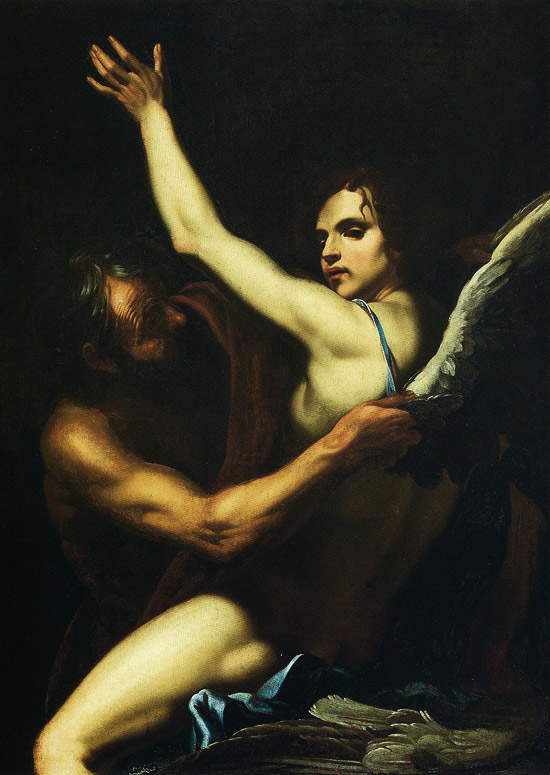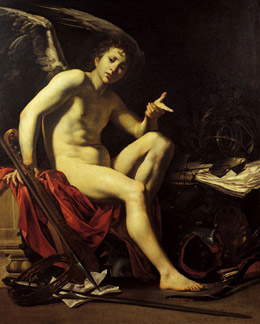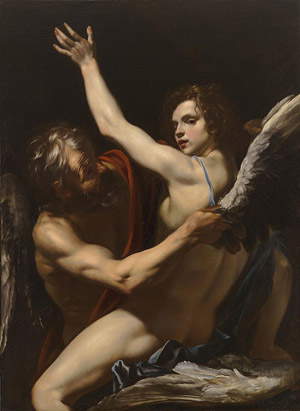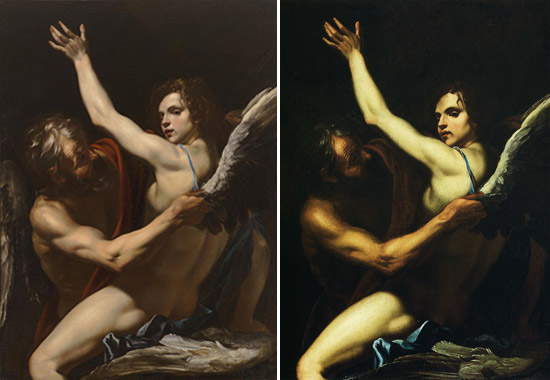Pariter praecepta volandi / tradit et ignotas umeris accomodat alas. / Inter opus monitusque genae maduere seniles, / et patriae tremuere manus.
“While teaching him to fly, behind his back he applied those wings he had never seen. And between the work and the admonitions, the old father’s cheeks grew wet, and his hands trembled.” (Ovid, Metamorphoses, VIII, 208-212)
The scene described by Ovid in his Metamorphoses is exactly what we see in the painting: Daedalus, the architect who designed the mythological Minotaur labyrinth, is applying a pair ofwings to the back of his son Icarus. The story is well known: the two, locked up by King Minos in the labyrinth because they were knowledgeable about the complicated structure, manage to escape thanks to the expedient of wings, which would have transported them away from the island of Crete, on which Daedalus’ building stood. The sadness that lines Daedalus’ face with tears in the Ovidian tale, rendered in the painting with an expression full of anguish, already foreshadows the bitter ending. Indeed, Daedalus warns Icarus, telling him not to get too close to the sun, because the wax that keeps his wings glued to his body would run the risk of melting. However, Icarus disregards his father’s warnings: the wax melts causing him to lose his wings, and the young man plummets into the sea, dying.
The painting we’re talking about is a work attributed to Girolamo Riminaldi (1601 - 1666), kept in the art collections of the Cassa di Risparmio di Carrara, and these days it is on display (until July 31) at the exhibition Pittura fra Toscana e Liguria nel ’600 a Carrara (Palazzo Binelli). This is a unique opportunity to become familiar with this virtually unknown artist: indeed, there are no certain paintings that can be referred to him. Even for the Carrara painting, in fact, there is no documentation that can assign it to Girolamo Riminaldi with certainty. Why then did it come to be named after this artist?
 |
| Girolamo Riminaldi (?), Daedalus and Icarus (ca. 1630; Carrara, Collezioni d’arte Gruppo Banca Carige) |
 |
| Orazio Riminaldi, Amore vincitore (1624; Florence, Palatina Gallery, Palazzo Pitti) |
Let us start with a premise: the surname Riminaldi is by no means new to those who are passionate about seventeenth-century art. In fact, Girolamo was the younger brother of Orazio Riminaldi (1593 - 1630), one of the most important Tuscan Caravaggisti: famous are his frescoes in the Pisa Cathedral (completed, moreover, by Girolamo: we can say this with certainty, based on the documents), and especially his Amore vincitore, a work preserved in Palazzo Pitti that, moreover, constituted one of the “highlights” of the exhibition on Caravaggio and the Caravaggeschi that was held, precisely in Palazzo Pitti, in 2010. Orazio had made a sojourn in Rome, where he kept abreast of the latest developments in Caravaggio’s painting, and then returned to Pisa, his hometown, in 1627: here, Orazio opened a flourishing workshop and, as was the case in the workshops of virtually all artists of the time, the most successful paintings that came out of it were replicated. From the number of replicas that are preserved of the painting with Daedalus and Icarus, we can deduce that the work had achieved wide acclaim.
 |
| Orazio Riminaldi, Daedalus and Icarus (c. 1625; Hartford, The Wadsworth Atheneum Museum of Art) |
Remarkably, the painting now assigned to Girolamo Riminaldi made a significant contribution to studies on the series dedicated to Daedalus and Icarus: we are in 1972, the work emerges on the antiquarian market, and art historian Mina Gregori proposes to attribute it to Orazio. In the same year, Evelina Borea confirms a hypothesis that had been circulating for a few years: that the version of the same painting conserved at the Wadsworth Atheneum Museum of Art in Hartford, Connecticut, is also the work of Orazio Riminaldi, and not of Bernardo Cavallino, the attribution with which the American museum had purchased the painting in 1944. In the following years several other versions of the painting emerged: one kept in a private collection in Malta, Valletta; another in a private collection in Florence, later sold by Christie’s in 1977 and recently reappeared in Cannes; and still three others, all in private collections (one in Venice, one in New York and one in Paris). Thanks to these discoveries, scholars had the opportunity to relate the paintings to each other, comparing the quality of the different paintings, so that they were able to figure out which was the prototype, that is, the work made first. And, nowadays, the version unanimously considered the prototype is the Hartford version.
What about the Carrara painting? How, then, does it fit into the scope of Orazio Riminaldi’s production? It must be said that, when it was discovered, it was thought to be the work of Orazio because it could not be compared with the other versions, which either had yet to be discovered or had attributions to be confirmed. By comparing the Carrara work with the Hartford one, it is possible to realize that, despite the fact that in both cases they are works of high quality, there are differences of no small importance: in particular, a lesser expressiveness of Icarus’s face in the Carrara painting, and a more meditated study of light in the American painting stand out (note the glares on the epidermis of the two protagonists, and on the locks of Daedalus’s hair).
 |
| Comparison of the two versions of Daedalus and Icarus: on the left the prototype, by Orazio Riminaldi (Hartford) and on the right the version assigned to Girolamo (Carrara) |
The curator of the exhibition currently underway in Carrara, Marco Ciampolini, has come to an interesting conclusion. He starts with an assumption: all known versions of Daedalus and Icarus have the same dimensions. This means that they were produced on the same cardboard, and therefore in the same workshop. Secondly, we must consider that Girolamo was very familiar with his brother’s art: if he had not been, the Opera del Duomo of Pisa would not have entrusted him, in 1630, with the task of completing the frescoes left unfinished by Orazio because of his untimely death. Finally, the difference in quality between the two paintings, which we have mentioned, might suggest two different, though very similar, hands: hence the reason for the name Girolamo Riminaldi.
To all this we add a curious note. We know of no certain works by Girolamo, for a very simple fact: that of a painter was not his main activity. By trade, Girolamo was an art dealer. But his ability to paint constituted no small competitive advantage for him: by painting himself, he could easily, and without having to turn to others, execute replicas of paintings that were in high demand on the market. It is highly probable that, given the success of Daedalus and Icarus, the Carrara version of the work can be considered to have been produced in this, so to speak, commercial context.
The exhibition Pittura fra Toscana e Liguria nel ’600 exposes the work, for the first time, to the general public: and since it had hitherto been little accessible even to scholars themselves, this could be a new, further opportunity to advance research on the figures of Orazio and Girolamo Riminaldi. Two artists excellently placed in the context of a Pisa that, at the time, was at the center of the trade between Genoa and Rome, and the artistic exchanges that took place between these cities, in this historical period, were particularly fruitful: another merit of the exhibition is precisely that of making the visitor understand how strong were the ties that united the main artistic poles of the seventeenth century. As well as that of displaying works whose access is, in most cases, precluded to the public, since the exhibition was entirely set up with works from bank collections. And the Daedalus and Icarus attributed to Girolamo Riminaldi is no exception: it is therefore worth hurrying, before this and other paintings return to their rooms... !
 |
| Girolamo Riminaldi (?), Daedalus and Icarus (c. 1630; Carrara, Collezioni d’arte Gruppo Banca Carige) - Detail |
Warning: the translation into English of the original Italian article was created using automatic tools. We undertake to review all articles, but we do not guarantee the total absence of inaccuracies in the translation due to the program. You can find the original by clicking on the ITA button. If you find any mistake,please contact us.